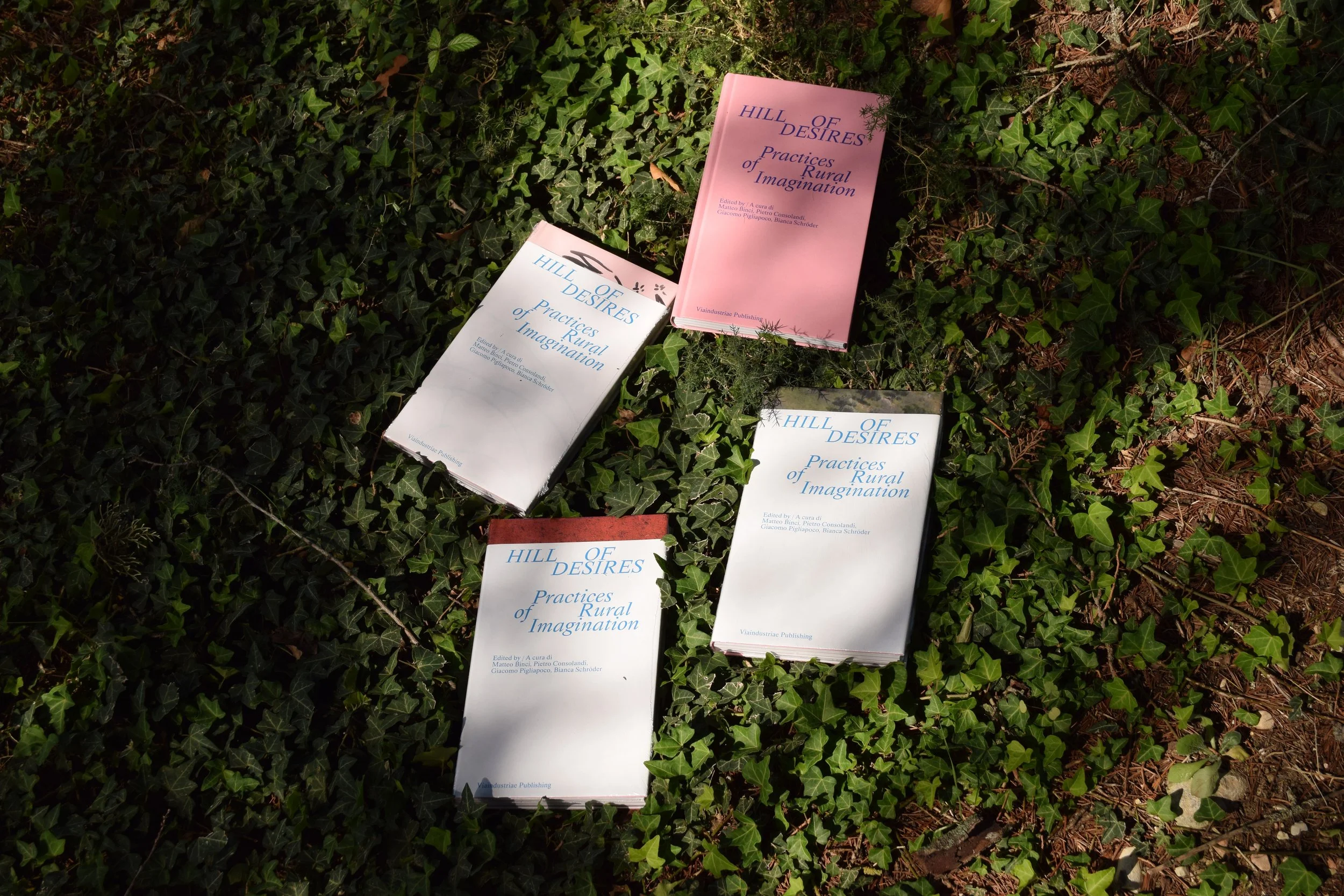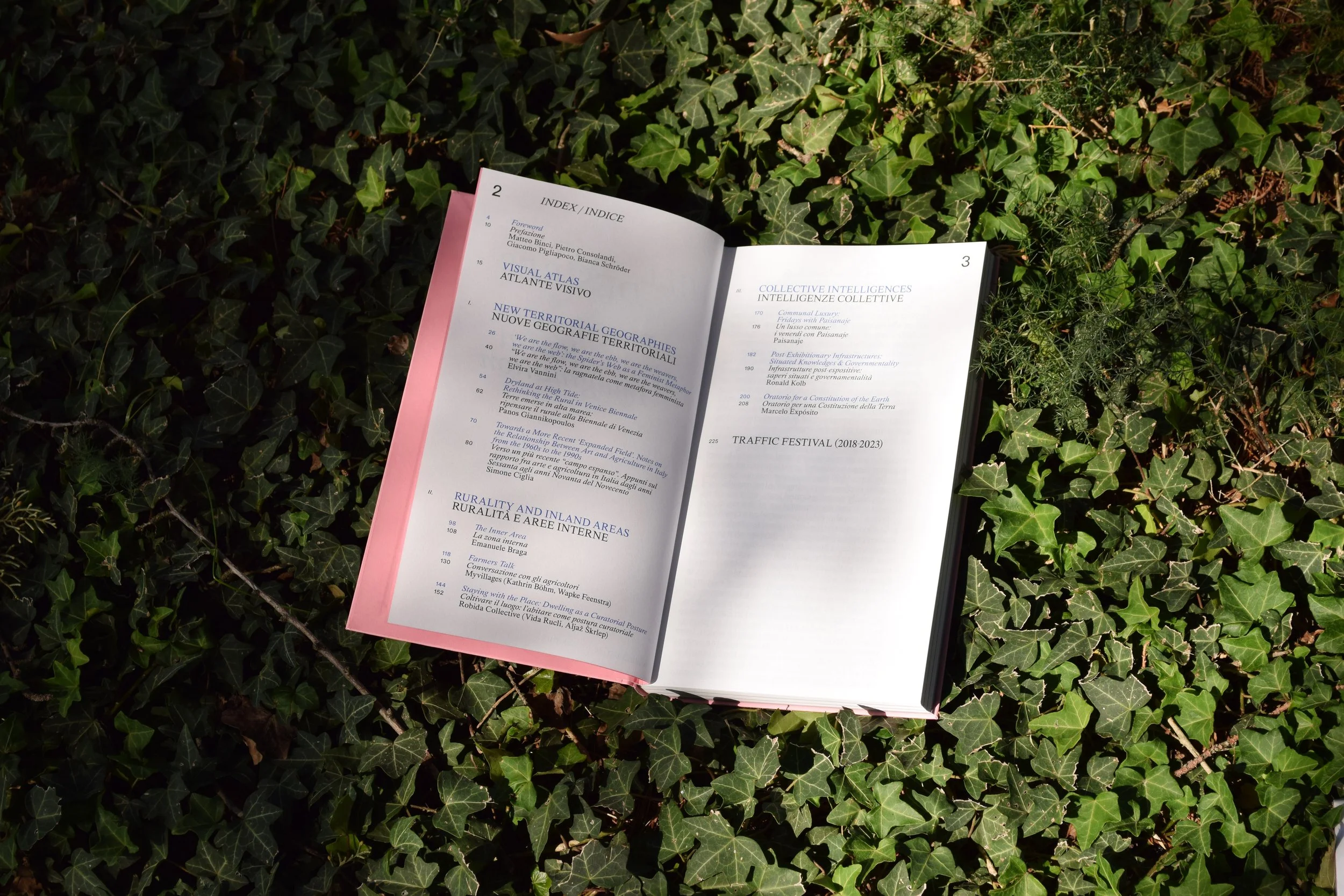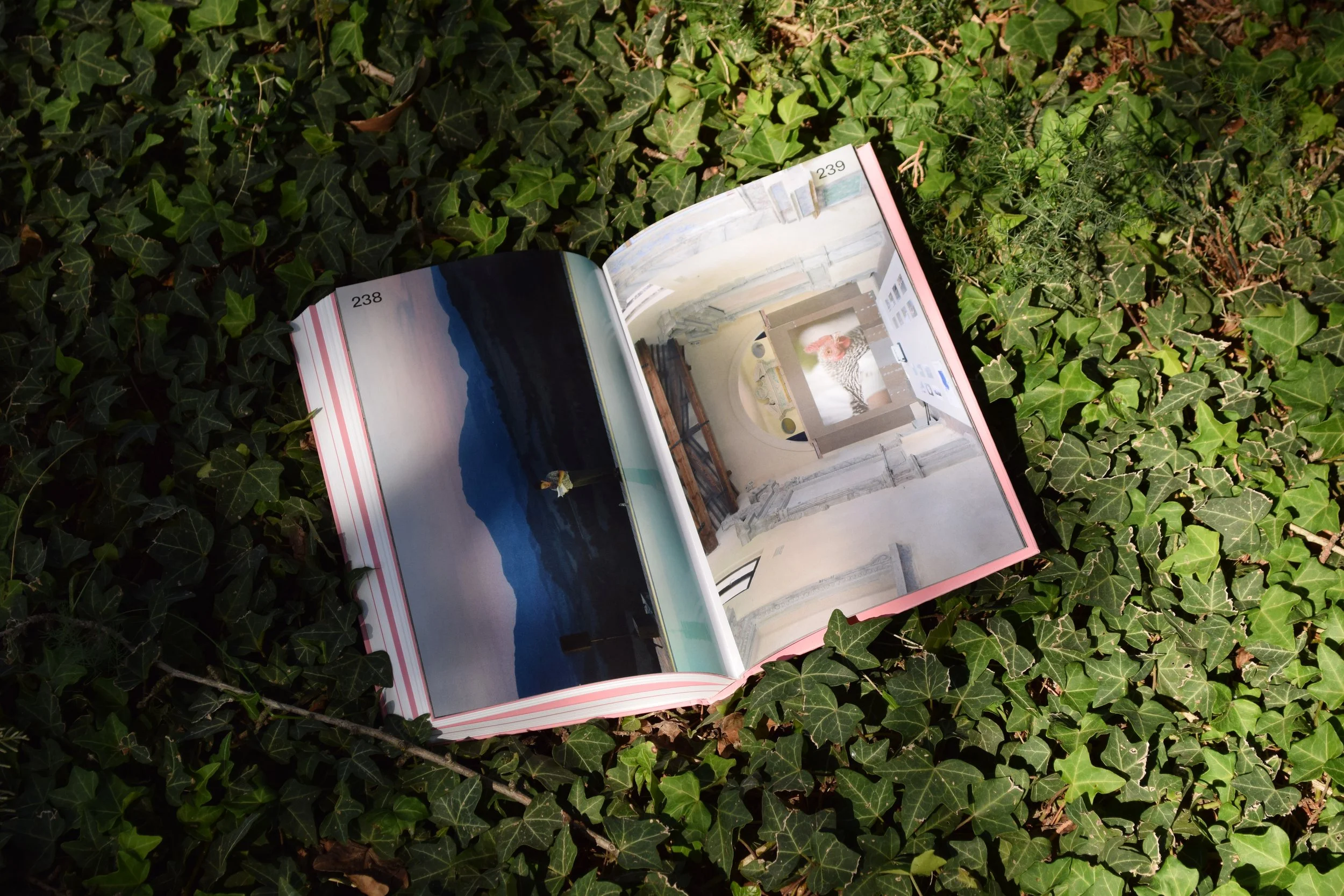EDITORIAL PROJECT
Hill of Desires, Viaindustriae Publishing, 2025.
Hill of Desires is a collective editorial device that conceives contemporary art as a situated practice rooted in European peripheral and inland territories. A radical exercise in imagination that embraces rurality as a space of counter-narration—capable of generating political ecologies, affective infrastructures, and non-institutional forms of knowledge. A critical contribution to the redefinition of cultural geographies and curatorial paradigms beyond the logic of the event.
The project is articulated in five sections: a visual atlas showcasing key artworks made in Italy from 1960 onwards, three commissioned artist-designed dust jackets, nine requested essays, a collective bibliography, and photographic documentation of the multi-year Traffic Festival.
The program of presentations involves artists, curators, researchers and professors through public programs, performances, book launches and workshops.
Edited by: Matteo Binci, Pietro Consolandi, Giacomo Pigliapoco, Bianca Schröder,
Texts: Emanuele Braga, Simone Ciglia, Marcelo Expósito,Panos Giannikopoulos, Ronald Kolb,Myvillages, Paisanaje, Robida, Elvira Vannini
Editorial coordinator: Matteo Binci
Research assistant: Amina Berdin
Producer: Anna Mostardi
Copy editing: Giulia Angeloni
Communication manager: Nicoletta Graziano
Publisher: Viaindustriae Publishing, Foligno (PG) www.viaindustriae.it
Graphic design: Viaindustriae Studio / Roberto Capozucca
Translations: Ben Bazalgette (ita - eng), Viaindustriae Studio (eng - ita), Alice Peach (editing / revisione)
Photography: Alisia Cruciani, Francesca Dondi, Benedetta Fioravanti, Lorenzo Placuzzi, Valentina Sammaciccia
Artist-design dust jackets: Jumana Manna, Foragers, 2022 Courtesy the artist and / l’artista e Hollybush Gardens, London / Londra © Jumana Manna; Maria Thereza Alves, Billions of Microorganisms Inhabit and Vitalize a Gram of Soil, 2025 Courtesy the artist / l’artista, Bianca Schröder, 222, 2025 Courtesy l’artista / the artist
The project is supported by the Italian Council program (2024) promoted by the Directorate- General for Contemporary Creativity of the Italian Ministry of Culture
Supported by: Comune di San Lorenzo in Campo, Comune di Loreto
The MPDS (Solo Suono) sound archive is a digital archive of 2603 audio files donated by Zerynthia to the Academy of Fine Arts in Rome in 2021. The collection consists of rare sound works by more than 200 artists, recordings of interviews and lectures on sound art, and unpublished documentation of happenings and concerts from the artistic experiments of Radioartemobile's Sound Art Museum (2002-2020), the private collections of Dora Stiefelmeier, Mario Pieroni, the Pieroni Gallery (1975-1992), and Maurizio Nannucci's Zona Radio archive (1974-1985).
The enhancement project involves academic institutions and more than 20 Italian and international professionals active in the field of sound art research through two conferences, a study day and two educational workshops at the ABA in Rome. The bilingual publication allows the collection to be presented to a diverse audience through critical texts commissioned, descriptions of works, artists' biographies, and a reference bibliography collectively produced together with those involved.
The publication is accompanied by a record that brings together a selection of works.
Sound Chronicles. MPDS Audio Archive
Project by: Zerynthia Associazione per l’Arte Contemporanea OdV
Edited by: Matteo Binci
Sound Works; Alvin Curran, Steve Piccolo, Michael J. Schumacher, Riccardo Giagni, Sonya Orfalian, Eva Marisaldi, Enrico Serotti, Carlo Crivelli,Danilo Cherni, Donatella Spaziani, Alessandro Tomei, Chris Burden, Maurizio Nannucci, Tomaso Binga, Jonas Mekas, Jimmie Durham, Maria Thereza Alves, Dmitri Prigov, Emilio Prini, Daniele Pieroni, Luigi Ontani, La Monte Young
Texts: Matteo Binci, Cecilia Casorati, Lucia Farinati, Federico Fusj, Riccardo Giagni, Lara Limongelli, Barbara London, Guely Morato Loredo, Claudio Libero Pisano, Salom. Voegelin
Vinyl sound works description: Matteo Binci
Research assistant: Amina Berdin
Editorial planning and coordination: Fabio Sisti
Publisher: Quodlibet
Graphic design: CH RO MO
English translations: Oliver Dorokstar
Italian translations: Maria Pieroni (pp. 61-79)
Vinyl record development and production: Fabio Sisti, Dubplate
Photo credits: Claudio Abate, Gino Di Paolo, Mario Di Paolo, Marco Fedele di Catrano, Monkeys Video Lab, Agostino Osio, Marco Paolini, Chiara Scategni, Yamina Tavani
Acknowledgements: ABA - Accademia di Belle Arti di Roma, ASFA - Athens School of Fine Arts, Cukrarna Gallery, MIDECIANT - Facultad de Bellas Artes Universidad de Castilla Maria Thereza Alves, Marco Amore, Valentino Catrical., Anna Cestelli Guidi, Matteo Costanzo, Emanuela Iannozzi, Donatella Landi, Susan Levenstein, Alessandra Monaco, Maurizio Nannucci, Ana Navarrete Tudela, Francesca Pellicci, Modestino Peluso, Blaž Peršin, Claudio Libero Pisano, Andrey Prigov, Studio Di Paolo, the students of ABA Roma, Daphne Vitali, Zafos Xagoraris
Sound Chronicles, Quodlibet, 2025.
"Rivoluzionare la spiritualità: Movimento della Dea ritualità femministe e politiche corporee”, in Ecce Homo, Roma, Museo Villa D’Este, Gangemi Editore, 2022
“You cannot buy the Revolution.
You cannot make the Revolution.
You can only be the Revolution.
It is in your spirit, or it is nowhere.”
(Ursula K. Le Guin, The Outsiders of the Other Planet)
Spirituality can contribute to a political transformation in the defining dynamics of bodies and reality if it considers unfolding forms of post-identity subjectivities that can overcome transcendent religious ties and scientific disenchantment with the world in order to affirm discursive alliances among living beings.
"Alessandra Ferrini. Negotiting Amnesia" in Colonialità e Culture Visuali in Italia, Milan, Mimesis, 2022
This volume analyzes the persistence of colonial imaginaries in contemporary visual cultures in Italy and the amnesic and aphasic politics reserved for Italian colonialism. The research explores the relationship between Italy and Africa as it was established at the time of the Italian colonial enterprise, its ideological arrangements as well as the posterity of toxic imaginaries, consciously or unconsciously shared and reproduced by the “imagined community” of the Italian nation. The essays by researchers herein analyze the role of cultural production in the ideological construction of racial narratives related to this history by critically traversing them. The theoretical work pursued in the volume is juxtaposed with the practices of Italian artists and African artists who, starting from different and complementary positionalities, have been able to weave a mesh of reflections on the contemporary legacy of a long, largely dissimulated historical period.
Curated by Simone Frangi and Lucrezia Cippitelli
"La natura dell 'impero" in Fuori. Quadriennale d'arte 2020, Rome, Treccani, 2020
FUORI is a publication that, in addition to bearing witness to the exhibited artists and the Quadriennale d'arte 2020 exhibition project, aims to outline new perspectives and methodologies for investigating contemporary Italian art. The bilingual book, Italian and English, designed to acknowledge the experimental nature of the exhibition and the work done over the past three years by the Quadriennale di Roma in support of Italian art, is aimed at visitors to the exhibition, the research community, students of contemporary art, artists and experts in the field. The volume consists of an introductory photographic section that traces the most emblematic events of the 2010s, and three macro-sections. The first is devoted to the exhibition, curated by Sarah Cosulich and Stefano Collicelli Cagol, whose essays written for the occasion aim to deepen the lines of research developed for the creation of the exhibition project. This is followed by speeches by Alessandro Bava, the architect in charge of the exhibition design; Luca Scarlini, writer, curator and, on this occasion, storyteller of the Quadriennale and its Library Archive; and Michele Bertolino and Matteo Binci, assistant curators of the exhibition.
With: Giorgina Bertolino, Stefano Chiodi, Silvia Fanti con Daniele Gasparinetti, Francesco Ventrella, Riccardo Venturi, Dafne Boggeri, Lucrezia Calabrò Visconti, Michele D’Aurizio, Vincenzo Estremo, Lorenzo Pezzani e Sofia Silva.
"Fare e disfare è tutto quel lo che so fare” in Biennale College ASAC - Scrivere in residenza 2019, Venice, La Biennale di Venezia and Marsilio, 2020
“Conceptual perfection and exactitude of knowledge can hide truth. Better to rely on a writing destined from the beginning to disorder, anti-discourse, incompleteness, to perdition.”
The text - a reply to the request to find forms of narrative for four national pavilions of the Art Biennale (2019) - is an attempt to move away from the forced aestheticization of any writing, the impracticability of copying, the inability to share, the unique and exclusive title that attempts to bring together the polyphony of voices, the impossibility of rewriting the existing and the absolute search for originality. I choose, voluntarily, the sand grain, the listening and the voice of the other within me, the carnal implication of desire in the writing, the open letter, the articulation as a form of signification, the possibility of being rewritten, the impossibility of holding everything together, but at the same time the attempt to do so. I write, keeping in mind the high rate of failure in assembling a text through: “a stammering and fragmentary announcement, marked by the divisions of the spirit”.
“Fight the Clergy, the State and Capital!” in Escuela Moderna, Chiese in fiamme, Milan, Milieu Edizioni, 2019
'Escuela Moderna/Ateneo Libertario' is a collective founded in 2009 in Barcelona by a multidisciplinary group of artists and scholars in homage to Francisco Ferrer y Guardia .
“Churches on Fire” approaches the Semana Trágica through multiple points of view. Iconographic, iconoclastic, pedagogical and anticolonial aspects are probed, as well as in-depth segments of the history of the labor and anarchist movement, the role of the Church and the anticlerical sentiment latent in Catalan society.
Along with historical and cultural analyses, the entire collection of postcards disseminated at the time by the Catalan publishing house ATV (Àngel Toldrà Viazo) is presented for the first time: 100 shots illustrating the burning city and the aftermath of the uprisings.
Moreover, thanks to the help of Eric Coulaud and the Centre International de Recherches sur l'anarchisme (CIRA) in Lausanne, it was also possible to recover some postcards sent at that historical moment from Barcelona to the most disparate points of the world.
Matteo Binci, art historian, makes a survey of the decline of Spanish imperialism, pointing out how the colonial war against Morocco, along with its propagandist re toric, will produce that strike, repressed in blood.
Matteo Binci, Edvige Cecconi Meloni, “Da quando sono al mondo”, in Pablo Fidalgo. Qualcosa nascerà da noi, Rome, Reale Accademia di Spagna, 2020.
Words and thoughts of love around the stage play Qualcosa nascerà da noi by Pablo Fidalgo.















